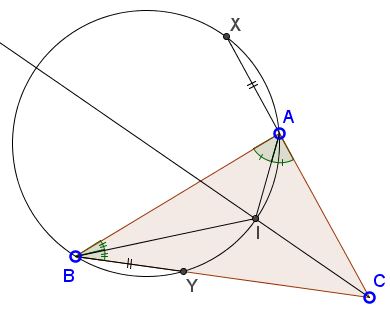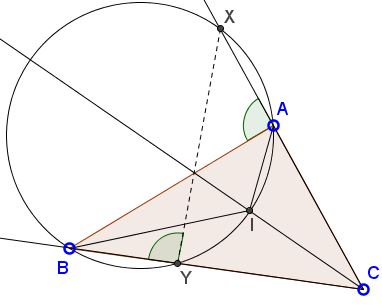Circle through the Incenter And Antiparallels
The applet below illustrates problem 7 from the 2009 Australian Mathematical Olympiad.
Let I be the incenter of a triangle ABC in which AC ≠ BC. Let Γ be the circle passing through A, I and B. Suppose Γ intersects the line AC at A and X and intersects the line BC at B and Y . Show that AX = BY.
The condition AC ≠ BC is obviously a red herring as, in this case,
|Activities| |Contact| |Front page| |Contents| |Geometry|
Copyright © 1996-2018 Alexander Bogomolny
Let I be the incenter of a triangle ABC in which AC ≠ BC. Let Γ be the circle passing through A, I and B. Suppose Γ intersects the line AC at A and X and intersects the line BC at B and Y . Show that

This is a well known fact that a circle through two vertices of a triangle cuts a chord (XY in the applet) antiparallel to the side joining the two vertices (AB in the applet).
In particular this means that ∠BAX = ∠BYX.

These angles are subtended by the arcs BXA and YBX. For the arcs (depending on the layout and assuming J is the second point of intersection of the circle with CI), either
BXA = BJX + XA,
YBX = YB + BJX,
or
BXA = BIX + XA,
YBX = YB + BIX,
In both cases the arcs XA and YB are equal, implying the identity of the subtended chords.
There are five solutions in all:
What Is Red Herring
- On the Difference of Areas
- Area of the Union of Two Squares
- Circle through the Incenter
- Circle through the Incenter And Antiparallels
- Circle through the Circumcenter
- Inequality with Logarithms
- Breaking Chocolate Bars
- Circles through the Orthocenter
- 100 Grasshoppers on a Triangular Board
- Simultaneous Diameters in Concurrent Circles
- An Inequality from the 2015 Romanian TST
- Schur's Inequality
- Further Properties of Peculiar Circles
- Inequality with Csc And Sin
- Area Inequality in Trapezoid
- Triangles on HO
- From Angle Bisector to 120 degrees Angle
- A Case of Divergence
- An Inequality for the Cevians through Spieker Point via Brocard Angle
- An Inequality In Triangle and Without
- Problem 3 from the EGMO2017
- Mickey Might Be a Red Herring in the Mickey Mouse Theorem
- A Cyclic Inequality from the 6th IMO, 1964
- Three Complex Numbers Satisfy Fermat's Identity For Prime Powers
- Probability of Random Lines Crossing
- Planting Trees in a Row
- Two Colors - Three Points
|Activities| |Contact| |Front page| |Contents| |Geometry|
Copyright © 1996-2018 Alexander Bogomolny
73600850
